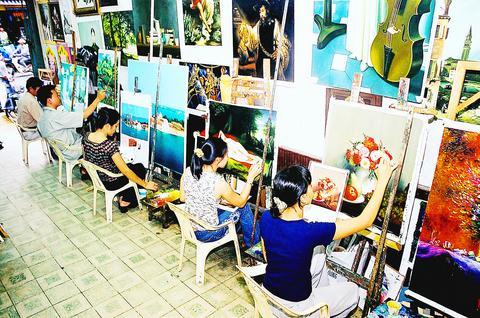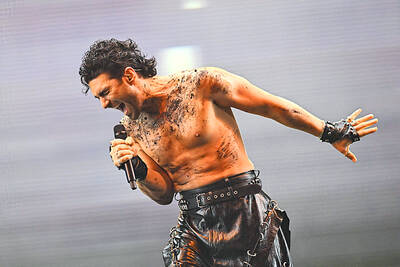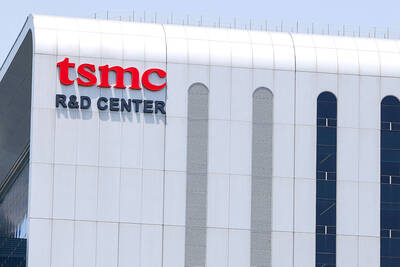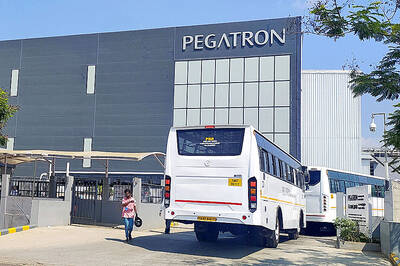As a child, Nguyen Thanh Tung was always fascinated by the beautiful paintings of Renoir.
Now a prosperous real estate dealer, the 30-year-old can finally afford to own some of the work by his favorite artist, even if they are only copies by Vietnam's skilled masterpiece painters.
Years of poverty and isolation from the West led many in communist Vietnamese to view art as a bourgeois extravagance. But now that has all changed.

PHOTO: REUTERS
Art buying is taking off, driven by a fast-growing middle class with a penchant for decorative furnishings.
While Vietnamese art is getting more space on the walls of galleries and private collections in London and Paris and individual paintings can command thousands of US dollars, at home it's reproductions of great masters that are winning admiration.
"For less than a thousand dollars I can turn my whole house into a replica of an impressionist museum," gloated Tung, admiring the sun-bathed landscape of Renoir's Le Mont Sainte Victoire in a Hanoi shop.
Esthetic cravings
Hundreds of shops and studios have sprung up in Vietnam's big cities to cater for the esthetic cravings of the emerging moneyed classes.
Tucked behind a murky cafe in southern Ho Chi Minh City, Ngo Dong's gallery doesn't much resemble Renoir's 19th century Paris studio but his works recall those of the impressionist master.
Waving his brush between a half-finished canvas of Renoir's La Grenouillere and a wooden palette of exotic colors, the 49-year-old painter said his copies have sold well, not just because of his skills, but also because of his deep empathy for the masters.
Demand for look-alike masterpieces is so great that Dong has to turn away "vanity" clients who want their portraits done.
On average, Dong's studio of six workers churns out 400 pieces a year with about half sold locally and the rest exported.
Prices are calculated on a basic rate of US$50 per square meter and US$20 extra for paintings with more than one face due to "more intricate copy work", Dong said.
The same reproduced painting is offered for as much as US$200 on eBay, the popular auction site.
French connection
"Vietnamese painters are much better at copying Western arts compared with painters in other Asian countries," Dong said.
Modern Vietnamese painting started in the 1920s, when the French colonial government established Ecole des Beaux-Arts de l'Indochine (Indochina School of Fine Arts).
It trained a generation of painters from across Indochina. The French influence explains why Vietnamese art appeals to Western eyes and the special skills of the painters.
Dong, a laureate of the People's Army Fine Art Award, also harbors ambitions to be famous for his own creations.
Wiping the dust off a large painting of three young girls facing a deep blue ocean, he said the only reason he was a prolific copier of other artists' works was to support his dreams of painting his own.
If that succeeds, Dong may be granted another wish -- to see, for real, Renoir's paintings in Paris.

The Eurovision Song Contest has seen a surge in punter interest at the bookmakers, becoming a major betting event, experts said ahead of last night’s giant glamfest in Basel. “Eurovision has quietly become one of the biggest betting events of the year,” said Tomi Huttunen, senior manager of the Online Computer Finland (OCS) betting and casino platform. Betting sites have long been used to gauge which way voters might be leaning ahead of the world’s biggest televised live music event. However, bookmakers highlight a huge increase in engagement in recent years — and this year in particular. “We’ve already passed 2023’s total activity and

BIG BUCKS: Chairman Wei is expected to receive NT$34.12 million on a proposed NT$5 cash dividend plan, while the National Development Fund would get NT$8.27 billion Taiwan Semiconductor Manufacturing Co (TSMC, 台積電), the world’s largest contract chipmaker, yesterday announced that its board of directors approved US$15.25 billion in capital appropriations for long-term expansion to meet growing demand. The funds are to be used for installing advanced technology and packaging capacity, expanding mature and specialty technology, and constructing fabs with facility systems, TSMC said in a statement. The board also approved a proposal to distribute a NT$5 cash dividend per share, based on first-quarter earnings per share of NT$13.94, it said. That surpasses the NT$4.50 dividend for the fourth quarter of last year. TSMC has said that while it is eager

‘IMMENSE SWAY’: The top 50 companies, based on market cap, shape everything from technology to consumer trends, advisory firm Visual Capitalist said Taiwan Semiconductor Manufacturing Co (TSMC, 台積電) was ranked the 10th-most valuable company globally this year, market information advisory firm Visual Capitalist said. TSMC sat on a market cap of about US$915 billion as of Monday last week, making it the 10th-most valuable company in the world and No. 1 in Asia, the publisher said in its “50 Most Valuable Companies in the World” list. Visual Capitalist described TSMC as the world’s largest dedicated semiconductor foundry operator that rolls out chips for major tech names such as US consumer electronics brand Apple Inc, and artificial intelligence (AI) chip designers Nvidia Corp and Advanced

Pegatron Corp (和碩), an iPhone assembler for Apple Inc, is to spend NT$5.64 billion (US$186.82 million) to acquire HTC Corp’s (宏達電) factories in Taoyuan and invest NT$578.57 million in its India subsidiary to expand manufacturing capacity, after its board approved the plans on Wednesday. The Taoyuan factories would expand production of consumer electronics, and communication and computing devices, while the India investment would boost production of communications devices and possibly automotive electronics later, a Pegatron official told the Taipei Times by telephone yesterday. Pegatron expects to complete the Taoyuan factory transaction in the third quarter, said the official, who declined to be